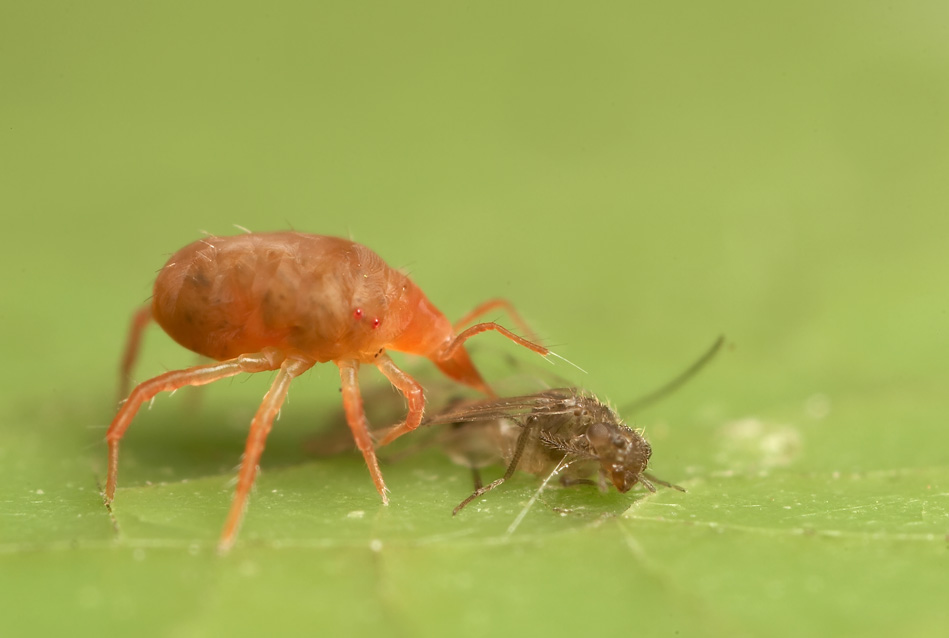Thread subject: Diptera.info :: Thrips sp. ?? and others
#1
Hi
I took this image today, 25th August 2006, in Silgueiros - Viseu - PORTUGAL. I put a pitfall that caught some very interesting insects and spiders.
Spiders belongs to the Gnaphosidae family. (all 4)
1 - Thrips sp. ???
2 - Wasp --- which family? it is wingless
3 - acari ??
4 - Collembolans
#2
"1 - Thrips sp. ???
2 - Wasp --- which family? it is wingless"
1 - Staphylinidae (Coleoptera)
2 - Mutillidae (Hymenoptera)

#3
And I agree with 3 and 4.

#4
Number one..................Staphylinidae

!
Half Elytron!!!!!!!
Calamity Camille

#5
4" not 1"= thrips!
3= mite in english (acarien)
#6
cthirion wrote:
4" not 1"= thrips!
3= mite in english (acarien)
Yes, it is mite. Sure.
But the 4 I think I have almost 99% sure that is collembolan. It is very different from Thrips sp.
#7
I think Jorge is right about 4 not being Thrips but Collembola.
Jan Willem
#8
On this photograph, number 4 has parts of different density on the body, the collemboles are more uniform in their structure............... but here it is very small, I am not sure! ?
?Strong dish for collemboles! ?
#9
cthirion wrote:
On this photograph, number 4 has parts of different density on the body, the collemboles are more uniform in their structure............... but here it is very small, I am not sure! ?
?Strong dish for collemboles! ?
the collembolan are very similar to this: http://www.geocities.com/fransjanssens/images/hopkin/2002/neanorum.jpg
I saw it with a small loupe...

#10
You see, not zone of shade on all the body! ?
?At the thrips, one sees the wings lying on the back! ?
?on your photograph, one sees zones of shade! ?
?But as long as I would not have a specimen seen under the magnifying glass........! ?

#11
Oh... I see. The right one.. has a black spot... it's dust!

)
The fine pelicule of water is not so clean...

Posted by
LordV on 05-09-2006 11:22
#12
My guesses would be
1. Rove beetle
3. Weevil
4.wasp ?
Brian V.
#13
LordV wrote:
My guesses would be
1. Rove beetle
3. Weevil
4.wasp ?
Brian V.
Hi Brian
4 never could be a wasp, 100% sure. I know this photo is not great. But I'm sure about this. This is indeed a collembolan.
3- seems more like a mite. Really I?m not sure about 3., indeed.
Thanks!
#14
Hi Jorge,
3 is Acari, no doubt!
Jan Willem
Posted by
LordV on 06-09-2006 09:19
#15
As a complete coincidence think I shot the same type of mite this morning (3) under 4:1
Brian V.

#16
LordV wrote:
As a complete coincidence think I shot the same type of mite this morning (3) under 4:1
Brian V.
wow!!! This is incredible! Fantastic "Micro" world!!! Acari with two red spots... and a very tiny insect.
#17
Brian - I think this has got to be the best shot of a predatory mite in action I have ever seen. I raise my pooter to you!

#18
What about its victim, is it a psocopteran?
Jan Willem
Posted by
LordV on 06-09-2006 18:32
#19
Thanks Tony- I didn't realise these were predatory- thought it was just an opportunist, I have a few mmore shots of it as well

. Jan yes think it is a bark louse it's eating.
Brian V.
#20
Yes, the Bdellidae are important mite predators. One species has been used in Tasmania for control of the "Lucerne Flea" - a destructive collembollan. Your photo shows the silk threads with which these mites tie down their prey before feeding.
An astonishing photo, reminiscent of some of the early screenshots from "Half-life" - (you may need to ask a gaming geek for an explanation - show them the image, and they'll know what I mean!)



 !
!


 )
)


 . Jan yes think it is a bark louse it's eating.
. Jan yes think it is a bark louse it's eating.